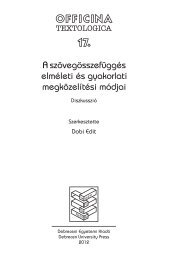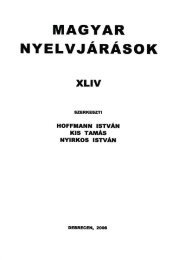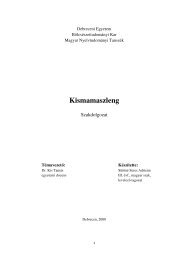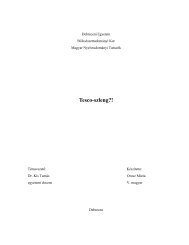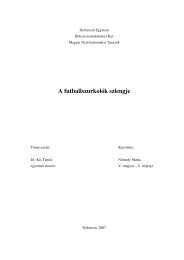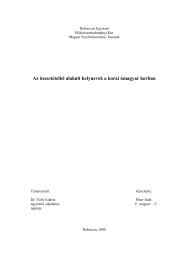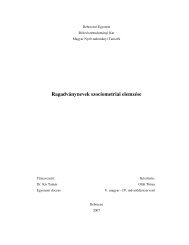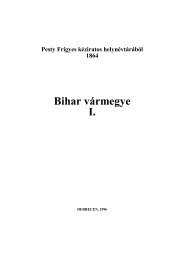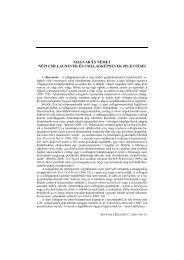Olavi Korhonen (Umeå, Sweden)
Olavi Korhonen (Umeå, Sweden)
Olavi Korhonen (Umeå, Sweden)
- No tags were found...
You also want an ePaper? Increase the reach of your titles
YUMPU automatically turns print PDFs into web optimized ePapers that Google loves.
<strong>Olavi</strong> <strong>Korhonen</strong> (Umeå, <strong>Sweden</strong>)The Place Name Jokkmokk, Jåhkåmåhkke1. IntroductionSituated in the interior of Norrbotten county, northern <strong>Sweden</strong>, is the smallmarket town of Jokkmokk, one of the best-known central communities inthe area populated by the Saami. In the early 17th century Karl IX initiatedthe establishment of official marketplaces and churches in order to strengthenthe power of the state in the north, 1 and, among others things, a suitablesite for a meeting place was needed in Lule Lapland. The site that was chosenlay at a confluence of the great River Lule, Julevuädno, which meandersits way down to the coast from the high mountains in the west of Lapland.One of the region’s Saami communities, Jokkmokk’s Forest Saami siida, 2used this place as a winter settlement (Sw. ‘vinterviste’), and during thesummer there were good connections to the surrounding lakes and to themountain region in the west. The Saami word for ‘vinterviste’, that is, theplace where Saami families gathered together during the coldest part of thewinter, is dálvvadis. 3 This is a derivative of dálvve, 4 ‘winter’, and becamethe early name of the place where Jokkmokk now stands. 5 It was probably at1 Jokkmokk was proclaimed by royal decree a market and magistrature centre in1605, but there had already been trade with Saami at points further down the RiverLule (BERGLING 1964: 146–147).2 A Saami foraging area as well as a group of Saami people living in it were referredto by this term that was translated into Swedish as sameby (‘Saami village’). Traditionally,the Saami area was divided between siidas which were the basic administrativeunits and also officially recognised by the authorities (editor).3 Note that the words referred to as simply ‘Saami’ in this article are not NorthSaami but represent those Saami varieties spoken in the areas under consideration,mostly Lule and, in some cases, Ume and South Saami (editor).4 The origin of Dálvvadis lies in the stem of the verb dálvvadit ‘let something besomewhere during the winter’ (HG 1070). Thus the name actually means ‘theplace where one lets something be during the winter’, the object in this case beingthe reindeer herd.5 Documents show that before the 17th century Sjokksjokk’s Forest Saami wintersettlement was used for markets (HOPPE 1944: 81–82, 84). A bog called Talwatisappi,Dálvvadisáhpe ‘winter settlement bog’, near Vuollerim is considered toindicate the place. The area lies on the southern stretch of land that passes theRiver Lule rapids at Vuollerim, and in 1732 LINNÉ wrote that following this route“we had to walk 50 km to Jokkmokk” (1913: 100). He was thus taking the southernroad past Vuollerim. Dálvvadis (with varying spellings according to dialect) is
The Place Name Jokkmokk, Jåhkåmåhkke201used topographical term for an inlet. 9 Instead the word requires a contextconnected with boating; it is a place where a boat could not go any furtherby the water because of some obstacle. An essential factor in this particularinterpretation is thus the navigability of the river and the nature of the landscapearound Jokkmokk. It is a fact that there were once long stretches of theRiver Lule that were used by boats (HOPPE 1945: 446). A late 16th-centurydescription of the major rivers around the Gulf of Bothnia mentions thateven then there were obstacles for boats quite near the coast in the Kalix,Pite, Skellefte and Ume rivers (AHNLUND 1928: 21). In the River Lule, onthe other hand, there were predominantly long stretches with a weak current,and even when land had to be crossed, this does not seem to have constituteda major obstacle for travel.Early travel accounts tell us how a boat journey could be made from thecoast up to Jokkmokk, and from there to Kvikkjokk (Saami Huhttán) orother places in the fell region. Two such accounts deal with the river close tothe coast. When Olof Swartz 10 was in Lule Lapland in 1780, he first went byboat up the River Lule and passed Sävastön near Boden. Just beyond thispoint the rapids made it impossible to continue by boat, and he was obligedto cross a well-known tract of land on foot. 11 Swartz calls this part of theroute ‘Hedmockan’ (roughly ‘strip of heathland’) after the nearby village ofHeden. 12 An alternative route would have been that investigated by C. M.Robsahm 13 in 1797. He had been given the task of finding out how the orefrom the Gällivare mines could most easily be transported to the ironworksat Selet. One possibility was to follow a route making use of the lake Mockträsket,14 which is a direct connection to the coast via the River Ale. 15 Thefact that there was a chapel and a market-place in Heden village (HÜLPHERS9 The usual word for ‘inlet’ is luokta (HG 440).10 OLOF SWARTZ (1760–1818), well-known botanist, undertook lengthy journeysboth in <strong>Sweden</strong> and abroad.11 In this tract of land a famous burial ground was unearthed, called the Brotjärnfind. It consisted of tools, clothing decoration and jewellery whose closestequivalents are thought to be from the later Viking period in southwest Finland(ODENCRANTS 1944: 96, SERNING 1960). Similar finds were made at a grave excavationat Vaikejaur, Vájgávrre.12 Swartz KB, M. 205: 5.13 Carl Magnus Robsahm (1776–1840), knighted in 1819 with the name Robson,was a widely-travelled mine supervisor and cartographer.14 In his account from the autumn of 1797 we learn that Robsahm travelled throughMockträsket and Mjödsjön (at present, Lake Mjösjön), and walked about 4 km ontwo stretches of land. The first was wet and difficult to walk on, but the secondwas a fine sandy heath (KB, M 200: 157–158).15 The River Ale was easily navigable up as far as Mockträsket even in the 18th century(HÜLPHERS 1789: 153).
202<strong>Olavi</strong> <strong>Korhonen</strong>1922: 83, HACKZELL [1731] 1928: 50, BERGLING 1964: 146–147) indicatethat this area of land has been important for a very long time. Thus we havea lake with the specific Mock- close to the lowest reaches of the river, and atraveller in Norrland uses the word mocka (in Hedmockan) for the stretch ofland he had to cross to pass the lowest rapids of the River Lule near theplace where the town of Boden is located today (map 1).A westerly boat journey on the River Lule from Heden could be continuedon long stretches of calm water. SAMUEL RHEEN’s survey from the 17thcentury contains some of the oldest pieces of detailed information aboutthese waterways. 16 The river was, quite naturally, also used by Saami travellingto the coast, 17 and the portages they crossed are characterised with theSaami term muorkke, Swedish ‘ed’, that is, ‘stretch of land (between navigablewaters)’. This became a loanword in the northern Swedish vocabularyin the form mårka, and this word achieved even wider distribution throughtravelogues and Norrland tourism-related literature. 18 Among the Saami ofLule Lapland the village of Heden was called Vuollemuorkke ‘the lowerplain’, 19 a name also recorded by J. A. NENSÉN, a well-known local historianand a clergyman in the early 19th century. 20 About 80 km to the westthose travelling by boat would encounter the next obstacle, the plain at Edefors,called Badjemuorkke ‘the upper plain’ in Saami. The next major obstructionwas the great rapids at Porsi (Porsiforsen) near Vuollerim,Vuolleriebme, now dammed up. The name Murkisträsket, that is, “the lakeby the the plain” may be found on the oldest topographical maps, north ofthe river. There is also a path marked out showing where to pass the rap-16 It describes how one could travel from ‘Luleå Kyrckia’ (Luleå Church, presentdayGammelstad) through ‘heeden till Hedeby (Heden)’ (the heath to Hedeby)and then across eighteen portages, which he enumerates, to reach the fell region(RHEEN 1897: 50).17 In the north-western part of the Mockträsket the name Lappberget (lit. ‘SaamiFell’) can be found, which may be a reminder of Saami journeys to the coast.Those who chose the route through Mockträsket had to cross a tract of land here.18 See NU 3: 173 and DAHLSTEDT 1950 I, 202, and maps 1 and 13, which show thatthe word mårka, a borrowing from Saami muorkke, Swedish ‘ed’, is found in dialectsas far south as northern Jämtland.19 Notes made by GRUNDSTRÖM (ULMA, 1932) and WIKLUND (UUB, WIKLUND40). This name is mentioned in connection with the Saami transportation ofgoods to the Jokkmokk market (PIRAK 1937: 21).20 NENSÉN’s example is the oldest and occurs in the form Wuollemurrke ‘Heden’(Heath). He also gives two words known to him for Swedish ‘ed’, namely murrkeand måkke, from Saami muorkke and måhkke respectively (UUB, R 649: 530).Regarding J. A. NENSÉN (1791–1881), see DRAKE 1918: XII–XIII. His remarkson Saami culture are of great value today.
The Place Name Jokkmokk, Jåhkåmåhkke203ids, 21 and Nensén calls this area Pårsemåkke (map 2). 22 It is impossible todetermine whether this name form is an approximation of the Saami -måhkke ora Swedish generic which can be considered a borrowing from Saami. In theSouth Saami region, where Nensén worked, the Swedish name-elementmåcke can, in fact, be found.We can see how the two Swedish terms mårka and mocka 23 occur variouslyin the names of tracts of land that interrupt navigable waterways. There arefurther examples of these terms along the rivers in the area north of theRiver Lule but I shall restrict myself to an illuminating group of names inthe River Lule valley, where it is also obvious that the terms are used synonymously.As Robsahm, at the end of the 18th century, is travelling towardsthe fell region he comes to a place about 10 km east of Jokkmokk, upriver from the village of Nelkerim, where he finds forceful rapids overwhich the baggage must be carried through a ‘morka’, which is 1/8 of a(Swedish) mile. 24 These rapids are Måkkforsen (map 3). When I interviewedlocal inhabitants in 1982, I was given valuable information about the watercoursejust here. Ecke Ek in Mattisudden declared that Måkkforsen was theonly place in the course of the river with a significant current in the stretchbetween Nelkerim, Nielggeriebme, and Jokkmokk. Bertil Andersson in Skällarimrecalled that in that stretch there were weak currents that a good oarsmancould negotiate, but in Måkkforsen ‘you couldn’t row there, but youcould make your way up it with a 3-horsepower outboard motor’. Aroundthese strong rapids there is a group of names with the same specific. Anearby stream is called Måkkbäcken; it passes through the mere Måkktjärnen,25 and people would moor their boats in the inlet of Måkkviken. 26There is common mooring place both above and below the rapids (BertilAndersson, Skällarim) and this demonstrates how important these placeswere. The highest fell north of the river is called Måkkberget and theMåkkheden, heath, lies just north of the river. Here a path can be found thatwas used during journeys in either direction. Thus the place name element21 Gn. Harads 1892. One notation says that ‘the lake is the first in a long series of lakesone passes when travelling overland past the Porsi Rapids’ (DAUM, PELLIJEFF 1936).22 The informant stated that Pårsemåkke is 20 km long, and lies in the place wherethe Greater and the Lesser Lule rivers meet (UUB, R 649: 222). He also used theword måkke of the stretch of land one crosses when making one’s way from thegreater to the lesser river (UUB, R 649: 614).23 Whether the spelling is with -å- or -o- is immaterial; I follow the usage most frequentin the sources. The vowels are identical in pronunciation.24 Robsahm KB, M 200: 163.25 cf. Swedish tjärn ‘small lake’ (editor).26 Names recorded in 1961 by PELLIJEFF (DAUM).
204<strong>Olavi</strong> <strong>Korhonen</strong>måhkke, found in many names in this district, has a clear connection with thestretch of land that travellers had to cross on foot to get past the rapids notonly during the summer, but also during much of the winter when the icewas unsafe. It has now been found, from accounts given by Saami informants,that these natural locations have names containing the other of the twoterms for Swedish ‘ed’, that is, ‘stretch of land (between waters)’. 27 The mostrecently attested toponym that is related to Måkkheden is Muorkásjvárre,literally ‘little plain fell’, the first element of which is a diminutive ofmuorkke, Swedish ‘ed, mårka’. There is a supplementary note in which theinformant explains how they would row on the calm water between the rapidsand walk past the rapids over the land. 28When Swartz and Robsahm approached Jokkmokk in the 18th century, theyleft their boats at Kyrkogårdsviken (lit. ‘Churchyard inlet’) in the RiverLesser Lule east of Jokkmokk (map 4). 29 They describe how they crossed aplain, or heath, past the place where Jokkmokk is located (1), and via lakesand stretches of land (2–8) continued towards the fells in the west. In Robsahm’stext we find the word mårka, and in one of the first places west ofJokkmokk there still is habitation named Mårkan today (between 3 and 4). 30Swartz, on the other hand, in his account of his journey, uses the term mockafor those places in which he was forced to walk. 31 But why choose that particularroute? The answer lies in the physical features of the area. One importantfactor was that the most difficult places for a traveller to negotiatewere in the River Lule north of Jokkmokk, and they were best to avoid. Herewere two great rapids Áhkásj- and Gájddomgårttje (the Akkatj and Kaitumrapids) which are now dammed up. They were impassable by boat and theshores were stony. Salmon were able to make their way up as far as theserapids, something that SAMUEL RHEEN implied as early as the 17th century;he mentions a number of salmon-fishing spots from Áhkásjgårttje (Wackiak)27 Note that Swedish ed also translates as ‘oath’ (editor).28 ULMA, GRUNDSTRÖM 1955.29 ROBSAHM arrived at an inlet in the river near Jokkmokk, at a point where the riverwas called Vahtjadis (Vatjates, Gn. 21 Jokkmokk, 1890), probably a derivative ofsjvahtjat ‘to be in motion’ (HG 1385). The word swattjatet ‘to set in motion’ (LÖ445) is accompanied by examples mentioning water being set in motion. ROBSAHMsays that ‘Wid Notudden var Elfven strömmande’ (KB, M 200: 165; ‘At Notuddenthe river flowed strongly’), which would seem to confirm my interpretation of thename.30 Ek. 26J 8–9 c–d Purkijaur.31 He rested in the village of Randijaur, Ráddnávrre, west of Jokkmokk, and thencame ‘til en liten Mocka eller Hed’ (’to a small plain or heath’) where the baggagehad to be carried ‘öfver mockan’ (’across the heath’). The boat was hauledup the rapids with ropes (KB, M 205: 12).
The Place Name Jokkmokk, Jåhkåmåhkke205down the river (RHEEN 1897: 65). Ernst Westerlund (b. 1886) had lived inJokkmokk since childhood, and told me in an interview in 1982 that he hadoften seen big salmon trying in vain to ascend the steep Akkatj rapids. Largequantities of salmon could be speared in the backwaters below the rapids,where the exhausted fish would gather.Up to this point I have only dealt with examples of place names in the RiverLule valley, but the Saami term måhkke can also be found in other Saami areas.Some of the clearest instances can be seen in the network of lakes fromwhich the River Skellefte, Syöldate, flows. The first is from the Ume Saamiregion in the Maskaur Saami village in southern Arjeplog, a part of Pite Lapland.Here, between Laisälven, Lájsso, and the lake called Ájsjávrre, there isa hill marked on the map as Muörkienåjvvie (map 5). 32 The first element isthe genitive form of the Ume Saami muörkkie, Swedish ‘ed, mårka’. NENSÉN,on the other hand, in describing the best crossing places between the watershere, uses the word måkke (with the Ume Saami spelling måhkkie). 33 Wehave already seen that NENSÉN prefers this topographical term, but it is obviousthat måhkkie and muörkkie were used in parallel by the local population.This is shown by an example from the south-eastern part of Lake Uddjaur,where according to a recent notation a particular area of land wascalled Måckan, Swedish ‘edet’ (roughly ‘the land between the waters’). 34 Inthat particular part of the lake, the waves could be so high in a strong windthat people preferred to walk rather than row along the shore. According toPETRUS LÆSTADIUS many people paled at the sight of the ‘rolling ridges ofthe waves’ (LÆSTADIUS 1977: 335). In this case the land passage made itpossible to avoid a difficult part of Lake Uddjaur, Ujják. Most other examplesare concerned with getting over the rapids.A traveller going southeast of Lake Storavan, Buovđđahávva, also one of thesource lakes of the river Skellefte, could choose to use either the southwesternor south-eastern route. The latter went in the direction of Arvidsjaur,Árviesjávrrie, and passed the village of Avaviken, Luokttamåhkkie, thename still used today by the Saami living in Arvidsjaur. 35 From Avaviken awell-known road running along ridges led right down to the Västerbotten32 The oldest map has Muorkenåive (Gn. 26 Lövmokk, 1893), which is the same asMuörkienåjvvie on modern maps (Blå kartan [Blue Map] 25H Arjeplog).33 He writes that one crosses ‘Aisjarmåkke’ in order to reach Ájsjávrre (UUB, R649: 222).34 DAUM, PELLIJEFF 1958, cf Blå kartan 251 Storavan.35 NENSÉN’s notation refers to both the deep inlet Luoktmåkke, which ‘is like aflood’, and the settlement ‘Storafvanwiken’, Luoktmåkke (UUB, R 649: 508 and475). COLLINDER also gives examples of the name (ULMA, 1937). HÜLPHERS attestedthe same name in the 1790s, in the form Lockt-mocki (1922: 57, note 4).
206<strong>Olavi</strong> <strong>Korhonen</strong>coastal area (HOPPE 1945: 97, 122; LASSILA 1972: 52). However, we areconcerned here with NENSÉN’s account of the easterly route to Arvidsjaurvia smaller lakes where one could row, and stretches of land where onecould walk (map 6). He says that from Avaviken there is a måkka, that is, atract of land, and it is five kilometers to the Dönfjället fjell, Dålggievárrie. 36If we then look at the western part of Lake Storavan, where there is an outletto the River Skellefte via the smaller Lake Naustajaure, Návstajávrrie, wefind another important portage (map 7). The area between the lakes is dominatedby the fell Muörkienåjvvie. On the earliest topographical map thisname is spelt Muotkenåive, 37 indicating a pronunciation with a preservedvoiceless dental spirant, that is, the Ume Saami Muöŧkienåjvvie, which hasalso been heard from a Saami informant. 38 Both voiced and voiceless dentalspirants have been preserved in certain villages within Arjeplog and Arvidsjaur.According to a later informant, on the other hand, the same fell is calledMåkkenåjve, which he says means ‘the fell between lakes’. 39 We can see thatthe two topographical terms muörkkie (muöŧkkie) and måhkkie exist side byside in the drainage area of the River Skellefte, just as in the River Lule region.Within the area in which South Saami is spoken—Åsele Lapland in southernVästerbotten—there are many names containing the Swedish element mocka(often spelt måcka or pronounced måcke). The vocalism with -å- is unexpected,since the northerly måhkke is pronounced mehkie in South Saami 40(earlier orthography mahkie). Let me present some examples from Vilhelmina.41 In the lake system west of Vilhelmina, Voeltjere, which led to theSaami summer habitation and meeting-place Fatmomakke, there are severalsuch names on maps and in the literature. Close to Vilhelmina we findMåckemyran 42 on the spit to Maksjön, Maakerenjaevrie, 43 and there are fur-36 Here the noun måkke is unambiguous; it is the stretch of land from the village to‘Dönfjället’, now Dunberget on modern maps (R 649: 475, cf. Blå kartan 241Storavan).37 Gn. 34 Storavan 1894, cf. Blå kartan 241 Storavan.38 Example from COLLINDER (ULMA 1930s).39 DAUM, PELLIJEFF 1958.40 See in BMM 1993: 186.41 See also account of names in DAHLSTEDT 1950: 201–206 and map 13.42 Blå kartan 22G Vilhelmina, DAUM, PELLIJEFF 1957.43 This pronunciation of the name comes from a Saami informant (ULMA, COLLIN-DER 1935). It is a word borrowed back from Swedish to Saami with a long a inthe first syllable that reverts to its pronunciation in the Swedish name Maksjön.The name element -re(n)- is a reduction of the South Saami -jaevrie with the additionof Swedish -n (definite form). This borrowing was possible because SouthSaami has the word maake ‘son-in-law’ (even other meanings; BMM 181), which
The Place Name Jokkmokk, Jåhkåmåhkke207ther examples in the upper reaches of the long Lake Malgomaj, Jetneme. Aninstance of Swedish name-forms in the literature is Vackemacksmyran (PET-TERSSON 1982 I, 109, 187), where the South Saami word vaegkie ‘valley,stretch of valley’ forms the specific. A tract of land named Gäddbäcksmocken44 (also Gäddbäcksmorkan, PETTERSSON 1982 I, 206, 258) representsthe same dualism in naming that we have already encountered severaltimes. A neighbouring farmhouse is called Mocken, 45 and continuing towardsLake Kultsjön, Gålhtoe, we finally see the mere Mocktjärn (PET-TERSSON 1982 II, 115). On the map, the name given to the important summersite Fatmomakke, Faepmie, contains the word final -makke, that is -mahkie (inmodern South Saami orthography -mehkie). This is situated close to the innerpart of an inlet from which a tract of land leads to the next navigable water;this was the start of the route to the Vilhelmina Saami summer habitationin the fells (map 8). The incidence of mocka is not restricted to theextreme west of Vilhelmina parish, but it is also found in the woodland areas.In Gafsele, for instance, we find the names Stenvattenmockan, Valvogsmockanand Måcken, meaning tongues of land between various stretches ofwater. 46 This is not an exhaustive collection of names from various parts ofLapland, but my examples will suffice to give an idea of the function ofthese name types in local descriptions of the landscape.3. The noun ‘måhkke’: distribution and etymologyIt can thus be seen that in names from Saami regions in the valleys of theRiver Lule, the River Skellefte and—as regards Vilhelmina—the RiverÅngerman, Swedish ‘ed’, that is, ‘stretch of land between waters’, two differentname elements are represented, corresponding to Saami nouns. One issimple: names with mårka ‘ed’, from Lule Saami muorkke, originate fromcontact between Saami and Swedish populations. In the case of other names,there is more uncertainty about the source language and the direction of borrowing.From the point of view of language history, Saami måhkke is a loanfrom West Finnish mukka, which corresponds to the standard mutka, 47 andthe Finnish meanings are essentially the same as the Saami. A question maywas thus not an original part of the name. The reconstructed Saami form shouldtherefore be *Mahkiejaevrie (with short a), that is synonymous with the SwedishMaksjön, often shown on maps as Måcksjön. O. P. PETTERSSON states quite correctlythat the name of the lake is connected with mahkie ‘strip of land that blocksa navigable waterway’ (PETTERSSON 1941 I, 7).44 DAUM, PELLIJEFF 1957.45 DAUM, PELLIJEFF 1957.46 DAUM, BERTIL FLEMSTRÖM 1958.47 Saami måhkke comes from West Finnish mukka (SKES 354, SSA II, 184).
208<strong>Olavi</strong> <strong>Korhonen</strong>arise as to whether Swedish mocka can be considered a loan from Saamimåhkke, but this is not plausible since the meaning ‘ed’ is not present in theSaami word. The Saami themselves used the word muorkke for ‘stretch ofland (between navigable waters)’. Turning to the Finnish word, we may askwhether it could have had any effect on those terms used in early times, eventhough Finnish is used today only in the vicinity of northernmost <strong>Sweden</strong>.And how are we to explain the vocalism in Swedish mocka (with variants) inthe South Saami region, where the vocalism of the Saami word mehkie (withthe earlier orthography mahkie)? These and other questions require a surveyof the relevant nouns in all three languages.An examination of the meanings conveyed by måhkke (Ume Saami måhkkie,South Saami mehkie) reveals that in the north it signifies ‘bend, curve orloop (in a tangible object, stream, shore, road, etc.)’ or ‘inlet (in a river,lake), ‘cove; nook’ (in a room, building)’. These concrete meanings haveyielded metaphoric use, namely meanings such as ‘destination, end, finish;purpose’. These are based on the idea of a journey as a way of getting “thereand back”—that is, the journey itself is a kind of ‘loop’. Most of thesemeanings are found as far as South Saami, but a few more appear in the regionunder investigation. The concrete meanings are the same as in thenorth, that is, ‘bend, curve (of a stream, valley, etc.)’, 48 and the metaphoricmeanings are also similar: ‘inner part, end (of a lake, valley, etc.); nook;(farthest) horizon’. A connection with movement and travel can be clearlyseen in the South Saami ‘destination, purpose’ and in ‘(reconnoitring) roundtrip’. From these meanings a development into ‘travel, journey, (stretch of)road’ can be considered natural. The latter meanings of the Saami word arenot found in the more northerly dialects. The word måhkke (with varyingpronunciations) occurs in all major Saami languages from the Kola Peninsulato South Saami, however. 4948 BMM 186, GH I, 21–22.49 DAHLSTEDT (1950: 203–206) regards Swedish mock(e) ‘stretch of land betweenlakes’, and corresponding place name elements within Vilhelmina as loans fromSouth Saami muerhkie (cf. Lule Saami muorkke) ‘mårka’. He considers that, just asþ (voiceless dental spirant) in Old Swedish maþker ‘mask’ (HELLQUIST 1948 I, 634)was in certain dialects replaced by k (makk ‘mask’), so could an earlier Saami*muetkie have become mock(e) in the Vilhelmina dialect. This possibility is, however,inconsistent with the fact that the pronunciation makk ‘mask’ is found onÖland and Gotland, in Uppland, Västmanland, Gästrikland and Dalarna (except inSärna and Idre), and also occurs in a transitional area in southernmost Hälsingland.South of kk, rk occurs in many places and rk is the predominant pronunciation inthe whole of northern <strong>Sweden</strong> starting from Hälsingland and Härjedalen (OSD). Inthe area of Norway that is closest, namely, Tröndelagen and the greater part of Helgeland,the pronunciation mark is found except for Vega, Brönnöysund and Korgen
The Place Name Jokkmokk, Jåhkåmåhkke209The main distribution area of Swedish mårka is in northern Lapland, whileas DAHLSTEDT has shown, mocka is most common in the south (Åsele Lapland),where it carries a clear sense of the Swedish ‘ed’ in the dialects. O. P.PETTERSSON, who in his study of Swedish dialects in Vilhelmina, explainsmocka (pronounced in the Vilhelmina dialect as mökk and mökke) as being‘a strip of land between two calm waters in a larger watercourse, very narrowor miles wide’. 50 For the River Lule we find only the appellative meaningin early travel accounts, but as far south as Bodum in northwest Ångermanland,where the Swedish ed is principally used, there are also examplesof mocka (pronounced mökk). One could say, dä ä barre n litn mökk, ‘it isonly a short distance’ (DAHLSTEDT 1950: 205–206). Compare this with theSouth Saami mäkkie sjäddaa duj goådiej raajaan ‘it will be a long journeyto those huts’. 51 Does mocka (with variants) along the northern rivers, in forexample Swartz’s and Nensén’s writings, have its origin in Åsele Lapland,where it occurs as a noun? Whatever the case, Nensén knew the term fromhis period of work in Dorotea in Åsele Lapland (DRAKE 1918: XII). In recentaccounts from informants in the parishes of Dorotea and Fredrika,mocka signifies ‘firmer ground between two waters’, and is found in a numberof nature names. 52 However, the place names I have cited from Lule andPite Lapland indicate that here too in earlier times the word was part of theeveryday vocabulary of the Forest Saami. It is quite conceivable that theterms mocka and måhkke were kept alive among the non-Saami and ForestSaami populations of that period, for whom trafficking on the rivers was amutual concern. Later on, however, the Saami måhkke (måhkkie) no longer retainedthe meaning ‘ed’ in everyday speech. This may, however, only reflectdeficiencies in the source material, since the Forest Saami were assimilatedearly on. We lack reliable sources regarding their vocabulary and the waysin which their speech may have differed from the more westerly Fell Saamivarieties. It is primarily their vocabulary that is now to be found in dictionariesand texts.Because the dialect collections in DAUM in Umeå 53 contained no examplesof mocka as a topographical term in the northernmost Swedish dialects, Itried interviewing a few elderly people in 1983 in villages close to the lakesUddjaur and Storavan in Arjeplog, Árjepluovve. Around this area there are,in the far north (Norwegian Dialect Archives, Oslo). Vilhelmina is thus surroundedby a large rk- area.50 ULMA, VILHELMINA, PETTERSSON.51 GH II, 899.52 DAUM, parish collection for Dorotea, Lisa Lidberg 1937.53 DAUM = Dialect, Place name and Folklore Archives in Umeå, containing Swedish,Finnish and Saami material from northernmost <strong>Sweden</strong>.
210<strong>Olavi</strong> <strong>Korhonen</strong>as we have seen, stretches of land with names containing both Saamimåhkkie and Swedish mocka. In the village of Mellanström I met SvenGranström, 79, and Wilma Holmgren, 75, who both knew the word mockain the sense ‘land between two stretches of navigable water’. Differing usageamong Saami and the settlers is also indicated in a leaf from Arjeplog,where a place named in a map Kuorpamuotke, Guorbbamuöŧkkie, is calledMåcka by an informant who has also added that this is ‘what the Swedescalled it’. 54 More interviews could perhaps have extended the geographicalrange of examples of the Swedish mocka. In any case, one way of findingout more about its background is to examine its function in fishing terminologyin the coastal dialects of Norrland. Mocka is used by the fishermen tomean the bent-over outermost part of a net, particularly a salmon net, andthe angular space thus formed. The term is also used of the rim of a hoopnet. 55 SAOB (the Swedish Academy Dictionary) has examples from 1751(mock-) and 1772 (måck-) onwards, but does not risk any etymologicalspeculation. 56 Word sheets in the language archives show the word occurring,with some variation of meaning, in the coastal areas of Norrbotten and Västerbotten,for example, måcka: ‘some kind of fishing-tackle, some kind of hoopnet’. It has now been established that the etymology of the term is Finnish. Itis a borrowing from West Finnish mukka, which along with a number ofother words made its way into rural dialects on the Swedish side of the Gulfof Bothnia. 57 Similarly, in northern Finland a salmon net called a mukkaverkko(verkko ‘net’) was used, the name referring to the looping over ofthe outer end of the net in order to get a better catch (MATTILA 1966: 5). Thenext question to be answered is whether the Finnish word with its linguisticvariants and its background in Finnish dialects can help us to understand theplace name elements mocka and måhkke.54 Gn. 34a3, ULMA, GRUNDSTRÖM 1935.55 OSVALD HÖGBERG describes the appearance of herring nets, salmon nets andhoop nets that had a so-called mocka. The term referred to the outermost bent orangled parts of the net rim, which increased the efficiency of the net (HÖGBERG1927: 24, 34, 35).56 See the word mocka in SAOB 17: 1201 and laxmocka 15: 372.57 One notation says that mocka is a ‘salmon net with the outer edge bent back over(meaning that the salmon were more efficiently caught)’, which is essential; itseems to have been an innovation in net and seine fishing, and considering theetymology, it must have been a Finnish-speaking population that introduced it.ÅKE HANSSON reports in a paper (off-print, no publication date) having found tensimilar obvious borrowings related to coastal livelihoods in Norrland. I have previouslywritten a paper on one of them, håp from Finnish haapio ‘small boatmade of an aspen trunk’ (KORHONEN 1982).
The Place Name Jokkmokk, Jåhkåmåhkke2114. Finnish mukka and mutka, occurrence and meaningsThe Saami måhkke is presented in etymological dictionaries as a loan wordfrom Finnish mukka, which in most meanings is identical to the literarymutka. 58 The consonant combination -kk- in mukka, which is the result of anassimilation from -tk-, has a West Finnish distribution. 59 Like many otherelements of the oldest Finnish settlement area in southern and centralFinland, the geminate consonant cluster of this word has spread to the colonisedregions in the north of the country and is now the form of the FarNorthern dialects. 60 Mutka on the other hand has East Finnish representationin the dialects and is part of the standard language. Irrespective of pronunciation,the meaning of the word is ‘curve, bend; winding’, and from these,such meanings as ‘detour’, ‘complication’ and ‘trick’ have developed. Inolder written Finnish mutka has approximately the same meanings 61 as thoseshown in later dialects material related to mutka ~ mukka. There are a fewdeviations, which are the names of certain curved objects (among others ‘asort of flail’, distribution northwest of Lake Ladoga; ‘harness-bow’, accordingto scattered examples and ‘salmon net with bent-in outermost part’, innorthwest Finland). 62 Mutka and mukka, in the meanings ‘bend, curve (inroad, waterway, etc.)’, are also common place name elements in most partsof Finland. Of particular interest in this context is the meaning ‘inlet’ (nounand place name element) within a restricted area near Lake Päijänne in Tavastia(in Finnish dialectology this area is called Päijänne-Tavastia [Fi. Päijät-Häme]),and in northern Finland (map 9). 63 In the former area there isalso the meaning ‘fringe, secluded spot, (remote) corner (of a field, etc.)’. 64Of the great number of toponymic instances with this meaning, most constitutethe names of fields and meadows, or areas of forest or land, for example,marchland and hollows.The two distribution pictures of mutka in Tavastia and mukka in northern Satakuntaand southern Ostrobothnia as noun and place name elements are interestingfrom the point of view of settlement history. They represent two wellknownareas of expansion in a northerly direction of Finnish hunting and58 According to SKES II, 354 and SSA, these sources refer to ERKKI ITKONEN (1969:144) who, nevertheless, has some doubts regarding this etymology.59 MATTILA 1966, KETTUNEN 1940, map 7. This is a recurring phenomenon characteristicof south-western Finnish. Similar features are also found in northernFinland (VIRTARANTA 1980: 175–186).60 VIRTARANTA 1980: 175–178, PAUNONEN 1987: 216–223.61 MATTILA 1966: 2–4, LÖNNR II, 1097.62 SMS, MATTILA 1966: 5 and map 1.63 MATTILA 1966: 39 and map 8.64 MATTILA 1966: 6 and map 9.
212<strong>Olavi</strong> <strong>Korhonen</strong>fishing activities (Finnish eränkäynti). 65 Apart from the difference in thephonetic form of the noun in the two areas, it is worth observing that theoriginal mutka from Tavastia has the meaning ‘inlet’ in both its core and inits expansion area in northern Finland (as the latter may well be considered).66 This extended meaning may be connected with a more frequent useof the word in contexts related to journeys via waterways to and from distantfishing and hunting grounds. The word obviously signified a place thatcould be reached by boat, but from where something in the natural environmentprevented further travel by water. The area in the west where mukkaoccurs is also a region with an ancient culture, which in historical presentationsand linguistic studies has been described as an area of early expansionto the north (map 10). In Tavastia, inland lakes and rivers were used forjourneys north, while the terrain in northern Satakunta and southern Ostrobothniamade it possible to start a journey by following the rivers towardsthe coast near the Kvarken straits, then to travel further in the Gulf of Bothniaregion and along the surrounding rivers. 67 Here we find no special developmentin name-elements or nouns, which agree with the main meaningsof the word in Finnish. In this case also, in the whole of northern Finland theword stem is used in its dual function both as a place name element and anoun meaning ‘bend, curve or loop’, referring to the geographical features.Mukka also made its way to northern <strong>Sweden</strong>, Finnish dialects in Finnmarkand the North Karelian region. We may speculate that this dissemination,which at various points reached the Saami areas, was behind the borrowingthat became Saami måhkke. In the North, the West Finnish word with its assimilatedform completely replaced the Tavastian term. On the other handthe meaning ‘inlet’ in many names and as an appellative has survived in thenorth, a sign of an earlier form having its origin in Tavastia. In point of factall toponyms referring to inlets in rivers are found in northern Finland.Meaning, frequency and the geographical characteristics of mutka both as atoponym element and a Tavastian appellative indicate quite clearly its closeconnection with a region frequently demonstrated in Finnish studies to bethe earliest and most active, as far as the spread of the population northwardsis concerned. This has been demonstrated not least by studies of Tavastianplace names with equivalents in the north. 68 In the course of time thetraces of Tavastian Finnish were overlaid not only with West Finnish lin-65 VAHTOLA 1980a: 120–126, VAHTOLA 1991: 196–197.66 MATTILA 1966: 39, 155 instances with the meaning ‘inlet’, c. 20 in Tavastia andthe remainder in northern Finland.67 LUUKKO 1954: 93–94, VAHTOLA 1980b: 292–308.68 VAHTOLA 1980b: 102–190.
214<strong>Olavi</strong> <strong>Korhonen</strong>Swedish population became predominant. Several place names that canclearly be identified as Finnish extend south to the area between the Luleand Pite rivers, and indeed even further south. 74 The name of the River Pite(Swedish Piteå) has been discussed in a number of contexts, and my interpretationis based on the Finnish dialect word piitta ‘steep bank of stream orriver, steep hill’. This is found with a narrow distribution in dialects thatvery closely corresponds to the distribution of the name-element and nounmukka. 75 The northern hunting journeys described in detail by Jaakkolamade use of the waterways in northern Satakunta to reach southern Ostrobothniaand from there the Gulf of Bothnia. 76 His account has been criticisedfor being provincial and patriotic, but many others since then have writtenabout the significance of this settlement route and substantially confirmedthe historical development.The next question is whether the circumstances I have described can explainwhy the place name element måhkke and the dialect word mocka in northern<strong>Sweden</strong> often mean Swedish ‘ed’, while Saami måhkke lacks this meaningin everyday speech. The less frequent meaning ‘inlet’ can be found in anumber of instances, but the usual Saami word for ‘ed’ is muorkke (withvariants). On the other hand, we have seen that Swedish mocka, which hasparticularly noticeable distribution among the Swedes of southern Västerbotten,referred to those stretches of land traversed on foot in the course ofjourneys on the water. I was able to determine the current use of the wordnear the Skellefte river. The Saami muorkke served as a designation forSwedish ‘ed’, and no synonyms were needed. Quite the contrary, the termwas so expressive and so frequent that it became a loan word in Swedishdialects, and even became a part of the standard northern Swedish. Mocka,on the other hand, led a more secluded existence as a dialect word, with itsgreatest frequency in Åsele Lapland in southern Västerbotten. Nevertheless,an analysis of Saami place names containing the element måhkke revealedthe contextual meaning of Swedish ‘ed’, which ultimately must havestemmed from the complex multilingual situation of an earlier period. Theborrowing of the Saami måhkke from Finnish mukka implies early and closecontact between the populations over a large area for a long time. It has beenestablished that the coastal population undertook fishing expeditions fromthe coast to the inland fishing lakes from as early as the 14th century, 77 and74 Names with obvious or assumed Finnish origins are, for example, Jörn, Kinnbäck,Hortlax, Rosvik, Kallax, Vittjärv, Niemisel, Ryssbält, Morjärv, Räktfors. See ED-LUND 1988.75 KORHONEN 1982: 87, cf. MATTILA 1966, map 10.76 JAAKKOLA 1924, VAHTOLA 1980b: 284, 308.77 HULTBLAD 1968: 158.
The Place Name Jokkmokk, Jåhkåmåhkke215traces of contacts from the coast up to the fells can still be seen in mockaand other terms in the Swedish coastal dialects. As long as there were contactsbetween Saami-speaking and Finnish-speaking populations, the twolanguages preserved the meanings of ‘their own’ words, but in language ofthe subsequently dominant Swedish population there was no longer the needfor this. There was now scope for semantic change. It is only in such multilingualenvironments that we can find examples of words and concepts detachedfrom their original meanings. The stronger position of Saami in thenorth meant that the Swedish dialectal mocka fell into disuse and was supersededby mårka in the meaning ‘ed’, but its influence from an earlier periodcan be traced today in a number of toponyms in the Lule river valley, as wasdemonstrated above.One of these names is Jokkmokk, Jåhkåmåhkke, the tract of land wheretravellers were forced to break off their river journey and use the lakes insteadto continue towards the fells. The name was not based on any Saaminaming motivation; rather it reflected the world-view of a traveller. TheSaami had their Dálvvadis, the place where they gathered together when thewinter was coldest and the snow deepest. In the summer the families spreadout in various directions to go fishing and hunting, and later to herd theirreindeer. The travellers stopped here before continuing their journeys. Jåhkåmåhkkedid not become a permanent settlement until the church, tollhouseand dwellings for the pastor, sexton and merchants were built. A ‘churchtown’ with huts also grew up, and soon the early character of the place wasforgotten. But it is still possible, at certain places on the ridge that extendsthrough the small market town of Jokkmokk, to observe the road that ledfrom the river up to the first lake. One such place is the area just south of theold church. Excavations at the site of the present hospital revealed the remainsof a building that had probably been the first church in Jokkmokk,dating from the 17th century (GRUNDSTRÖM 1930). The remains of bones inthe ground indicated that the first churchyard lay here as well. All theseplaces are located close to the stretch of land that travellers crossed on theirjourney to the west. Place names are much more than names; they are historicaldocuments waiting to tell their story.AbbreviationsBMM = Bergsland, Knut–Matsson, Magga 1993.DAUM = Dialekt-, ortnamns- och folkminnesarkivet i Umeå.Ek. = Ekonomisk karta över Sverige.GH see Hasselbrink 1981–85.Gn. = Generalstabskartan.
216<strong>Olavi</strong> <strong>Korhonen</strong>HG see Grundström 1946–54.KB = Kungliga Biblioteket [The Swedish Royal Library], Stockholm.LÖ see Lindahl–Öhrling 1780.LÖNNR see Lönnrot (1874–80) 1958.OSD = Språkprov i Ordbok över Sveriges dialekter. Uppsala.R see UUB.SMS = Suomen murteiden sanakirjan kokoelmat.SSA = Suomen sanojen alkuperä.ULMA = Dialekt- [earlier: Landsmåls-] och folkminnesarkivet i Uppsala[Institute of Dialect and Folklore Research, Uppsala].UUB = Uppsala Universitetsbibliotek [Uppsala University Library].ReferencesAHNLUND, NILS (ed.) (1928) Olof Tresk. Kartor över Kemi & Torne lappmarker1642 och 1643. Stockholm.BERGLING, RAGNAR (1964) Kyrkstaden i övre Norrland. Kyrkliga, merkantilaoch judiciella funktioner under 1600- och 1700-talen. SkytteanskaSamfundets handlingar 3. Uppsala.BERGSLAND, KNUT—LAJLA MATSSON MAGGA (1993) Åarjelsaemien —daaroen baakoegærja — Sydsamisk-norsk ordbok. Alta.DAHLSTEDT, KARL-HAMPUS (1950) Det svenska Vilhelminamålet. Allmäninledning. Ord och betydelser. Skrifter utgivna genom Landsmåls- ochFolkminnesarkivet i Uppsala. A: 7. Uppsala.DRAKE, SIGRID (1918) Västerbottenslapparna under förra hälften av 1800-talet. Lapparna och deras land. Skildringar och studier utgivna av HjalmarLundbohm VII. Uppsala.EDLUND, LARS-ERIK (1988) Några maritima perspektiv på det bottniskaortnamnsförrådet samt aspekter på kulturgränser inom det nordnorrländskaområdet. Det maritima kulturlandskapet kring Bottenviken. Artiklaroch studier från Bottenviksprojektet. Umeå.GRAAN, OLAUS (1899) Relation, eller en fullkomblig beskrifning om lapparnasvrsprung, lefwernes förehållande. Bidrag till kännedom om de svenskalandsmålen ock svenskt folkliv XVII/2. Uppsala.GRUNDSTRÖM, HARALD (1930) Ett gammalt gravfält i Jokkmokk. Norrbotten1930. Luleå.GRUNDSTRÖM, HARALD (1946–54) Lulelapsk ordbok 1–4. Skrifter utgivna genomLandsmåls- och folkminnesarkivet i Uppsala. Ser. C I: 1–4. Uppsala.HACKZELL, NILS (1731) (1928) Staden Luleå och dess grannsocknar. Norrbotten1928. Luleå.
The Place Name Jokkmokk, Jåhkåmåhkke217HASSELBRINK, GUSTAV (1981–85) Südlappisches Wörterbuch — Oårjelsaamienbaaguogärjaa I–III. Skrifter utgivna genom Dialekt- och folkminnesarkiveti Uppsala. C: 4. Uppsala.HELLQUIST, ELOF (1948) Svensk etymologisk ordbok I–II. Tredje uppl. Malmö.HOLMBÄCK, ÅKE (1922) Om lappskattelandsinstitutet och dess historiskautveckling. Statens offentliga utredningar 1922: 10. Stockholm.HOPPE, GUNNAR (1945) Vägarna inom Norrbottens län. Geographica 16.Uppsala.HULTBLAD, FILIP (1968) Övergång från nomadism till agrar bosättning iJokkmokks socken. Acta Lapponica XIV. Lund.HÜLPHERS, ABRAHAM ABRAHAMSSON (1789) Samlingar til en Beskrifningöfwer Norrland. Femte samlingen om Westerbotten. 1 Bandet. Westerås.HÜLPHERS, ABRAHAM ABRAHAMSSON (1922) Samlingar til en beskrifningöfwer Norrland. 5: 3. Lappland. Utgiven av G. Kallstadius. Stockholm.HÖGBERG, OSVALD (1927) Fiske i Lule skärgård. Svenska landsmål ocksvenskt folkliv 1926. Uppsala.ITKONEN, ERKKI (1969) Lappische Chrestomatie mit GrammatikalischemAbriss und Wörterverzeichnis. Hilfsmittel für das Studium der finnischugrischenSprachen VII. Helsinki.JAAKKOLA, JALMARI (1924) Pirkkalaisliikkeen synty. Turun SuomalaisenYliopiston julkaisuja. Sarja B, osa II, n:o 1. Turku.KETTUNEN, LAURI (1940) Suomen murteet. III. A. Murrekartasto. Helsinki.KORHONEN, OLAVI (1982) Samisk–finska båttermer och ortnamnselementoch deras slaviska bakgrund. En studie i mellanspråklig ordgeografi ochmellanfolklig kulturhistoria. Skrifter utgivna av Dialekt-, ortnamns- ochfolkminnesarkivet i Umeå. Umeå.LASSILA, MAUNO (1972) Vägarna inom Västerbottens län. Kommunikationernasutveckling mot bakgrund av befolkning och näringsliv. Umeå.LINDAHL, E.—ÖHRLING, J. (1780) Lexikon Lapponicum. Holmiae.LINNÉ, CARL VON (1913) Iter Lapponicum. (Uppsala.) Stockholm.LUUKKO, ARMAS (1954) Pohjois-Pohjanmaan ja Lapin keskiaika sekä1500-luku. Pohjois-Pohjanmaan ja Lapin historia II. Oulu.LÆSTADIUS, PETRUS (1831) (1977) Journal för första året af hans tjenstgöringsåsom missionaire i Lappmarken. Petrus Læstadius Journaler. Faksimilietextoch kommentar. Kungl Skytteanska Samfundets handlingar 15:1. (Stockholm) Umeå.LÖNNROT, ELIAS (1874–80) (1958) Suomalais–Ruotsalainen Sanakirja I–II.Porvoo.MATTILA, RIITTA (1966) Sana mutka ja sen synonyymeja Suomen paikannimissä.Pro gradu-tutkielma. Helsingin yliopiston Suomen kielen laitos.Helsinki.
218<strong>Olavi</strong> <strong>Korhonen</strong>NU = Norrländsk uppslagsbok 1–4. Red. LARS-ERIK EDLUND. Umeå, 1993–1996.ODENCRANTS, R. (1944) Brotjärnsfyndet. Norrbotten 1943. Luleå.PAUNONEN, HEIKKI (1987) De finska dialekterna på Nordkalotten och derasförhållande till de andra finska dialekterna. Nordkalotten i en skiftandevärld. Kulturer utan gränser och stater över gränser. Studia historicaseptentrionalia 14: 2. Rovaniemi.PETTERSSON, OLOF PETTER (1941–60) (1982) Gamla byar i Vilhelmina I–IV. Stockholm (I–III.), Uppsala (IV.). Kungl Skytteanska Samfundetshandlingar 23: 1–2. Facsimilieupplaga. Umeå.PIRAK, ANTA (1937) Jåhttee saamee viessoom. Skrifter utgivna av K HumanistiskaVetenskaps-Samfundet i Uppsala 31: 2. Uppsala.RHEEN, SAMUEL (1897) En kortt relation om lapparnes lefwarne och sedher,wijd-skiepellsser, sampt i många stycken grofwe wildfarellsser. Bidragtill kännedom om de svenska landsmålen ock svenskt folkliv XVII, 1.Uppsala.OAB = Ordbok över svenska språket utgiven av Svenska akademien. Lund,1898–.SERNING, INGA (1960) Övre Norrlands järnålder. Umeå.SKES = Suomen kielen etymologinen sanakirja I–VI. Red. Y. H. TOIVO-NEN—ERKKI ITKONEN—AULIS J. JOKI—REINO PELTOLA. Lexica SocietatisFenno-ugricæ XII, 1–6. Helsinki, 1955–78.SSA = Suomen sanojen alkuperä 1–3. Red. ERKKI ITKONEN—ULLA-MAIJAKULONEN. Helsinki, 1992.VAHTOLA, JOUKO (1980a) De finska ortnamnen i Nord-Skandinavien ochderas nyttjande som historisk källa. Nord-Skandinaviens historia i tvärvetenskapligbelysning. Red. E. BAUDOU—K-H. DAHLSTEDT. Acta UniversitatisUmensis. Umeå Studies in the Humanities 24. Umeå.VAHTOLA, JOUKO (1980b) Tornionjoki- ja Kemijokilaakson asutuksen synty.Nimistötieteellinen ja historiallinen tutkimus. Studia Historica Septentrionalia3. Rovaniemi.VAHTOLA, JOUKO (1991) Folkens mångfald. Tornedalens historia I. Frånistid till 1600-talet. Red. by YRJÖ ALAMÄKI—OLOF HEDERYD—MATTIKENTTÄ. Haparanda.WIKLUND, K. B. (1928) Norrbottniska socken- och kapellnamn av lapskt ochfinskt ursprung. Norrbotten. Läsebok för skola och hem II. Utg. av G.Bergfors och A. Neander. Stockholm.VILKUNA, KUSTAA (1975) Unternehmen Lachsfang. Die Geschichte derLachsfischerei im Kemijoki. Studia Fennica 19. Helsinki.VIRTARANTA, PERTTI (1980) De finska dialekterna i Nord-Skandinavien ochderas historiska bakgrund. In: Nord-Skandinaviens historia i tvärvetenskapligbelysning. Red. by E. BAUDOU—K-H. DAHLSTEDT. Acta universitatisUmensis 24. Umeå.
The Place Name Jokkmokk, Jåhkåmåhkke219Unpublished sourcesKB, M 200, Dagbok under resor i Vesterbotten och Lappland 1797–1800 avC. M. Robsahm.KB, M 205, Dagbok öfver min resa till Lappmarcken 1780 av Olof Swartz.UUB, R 649, 650 Samlingar om samisk kultur 1818–1841 av J. A. Nensén.
220<strong>Olavi</strong> <strong>Korhonen</strong>Map 1 Map 2Map 3
The Place Name Jokkmokk, Jåhkåmåhkke221Map 4Map5
222<strong>Olavi</strong> <strong>Korhonen</strong>Map 6Map 7 Map 8
The Place Name Jokkmokk, Jåhkåmåhkke223Map 9 Map 10



